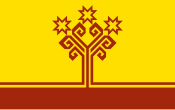தெங்கிரி மதம்
தெங்கிரி மதம் என்பது ஒரு நடு ஆசிய மதம் ஆகும். ஷாமன் மதம் உள்ளிட்ட பல மதங்கள் ஒரு தொகுப்பாக தெங்கிரி மதம் என்று அழைக்கப்படுகின்றன.[1][2][3] இது துருக்கியர்கள், மங்கோலியர்கள், ஹங்கேரியர்கள், சியோக்னு, ஹூனர்கள்[4][5] மற்றும் பண்டைய ஐந்து துருக்கிய மாநிலங்கள்: கோதுர்க் ககானேடு, மேற்கு துருக்கிய ககானேடு, பெரிய பல்கேரியா, பல்கேரியப் பேரரசு மற்றும் கிழக்கு துருக்கியா (கசாரியா) ஆகியவற்றின் மதம் ஆகும். துருக்கிய புராணமான இர்க் பிடிக்கில், தெங்கிரி துருக் தங்ரிசி (துருக்கியர்களின் கடவுள்) என்று குறிப்பிடப்பட்டுள்ளார்.[6]
1990களில் சோவியத் ஒன்றியம் கலைக்கப்பட்ட பிறகு தெங்கிரி மதம் நடு ஆசியாவின் துருக்கிய நாடுகளின் (தாதர்த்தான், புர்யாத்தியா, கிர்கிசுத்தான் மற்றும் கசக்கஸ்த்தான் உட்பட) அறிவுசார் வட்டங்களில் பரிந்துரைக்கப்படுகிறது.[7] இம்மதம் இன்னும் பின்பற்றப்படுகிறது. இது சகா குடியரசு, காகஸ்ஸியா, துவா மற்றும் பிற சைபீரியத் துருக்கிய நாடுகளில் ஒழுங்கமைக்கப்பட்ட மறுமலர்ச்சிக்கு உள்ளாகியுள்ளது. தெங்கிரி மதம் போலவே உள்ள புர்கான் மதம் அல்த்தாய் குடியரசில் பின்பற்றப்படுகிறது.
மங்கோலிய மொழியில் குக் தெங்கிரி என்பதன் பொருள் "நீல வானம்" ஆகும். மங்கோலியர்கள் இன்றும் முன்க் குக் தெங்கிரியை ("எல்லையற்ற நீல வானம்") பிரார்த்தனை செய்கின்றனர். சில நேரங்களில் மங்கோலியா செய்யுள் நடையில் "எல்லையற்ற நீல வான நிலம்" (முன்க் குக் தெங்கிரீன் ஓரோன்) என்று மங்கோலியர்களால் அழைக்கப்படுகிறது. நவீன துருக்கியில், தெங்கிரி மதம் கோக்தன்ரி தினி ("வான் கடவுள் மதம்") என்று அழைக்கப்படுகிறது;[8] துருக்கியச் சொற்களான "கோக்" (வானம்) மற்றும் "தன்ரி" (கடவுள்) முறையே மங்கோலியச் சொற்களான குக் (நீலம்) மற்றும் தெங்கிரி (வானம்) உடன் பொருந்துகின்றன. ஹங்கேரிய தொல்பொருள் ஆய்வின்படி, கி.பி. 10ம் நூற்றாண்டு இறுதி வரை (கிறித்தவ மதத்திற்கு முன்பு) ஹங்கேரியர்களின் மதம் தெங்கிரி மதம் ஆகும்.[9]
பின்னணி
[தொகு]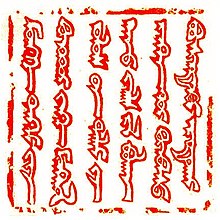

தெங்கிரி மதத்தினர் தாங்கள் வாழக் காரணம் எல்லையற்ற நீல வானம் (தெங்கிரி), வளமான தாய்-பூமி ஆன்மா (எஜே) மற்றும் வானத்தின் தூய ஆன்மாவாகக் கருதப்படும் ஆட்சியாளர் ஆகியோர் என நினைக்கின்றனர். சொர்க்கம், பூமி, மற்றும் இயற்கை மற்றும் முன்னோர்களின் ஆன்மாக்கள் எல்லாத் தேவைகளையும் பூர்த்தி செய்து அனைத்து மனிதர்களையும் காப்பதாகக் கருதுகின்றனர். நேர்மையான, மரியாதைக்குரிய வாழ்க்கையை வாழ்வதன் மூலம் ஒரு மனிதன் தன் உலகத்தை சமநிலையிலும், தன் தனிப்பட்ட காற்றுக் குதிரை அல்லது ஆன்மாவை சரியாக ஆக்கவும் முடியும் எனக் கருதுகின்றனர். வடக்குக் காக்கேசியாவின் ஹூனர்கள் இரு கடவுள்களில் நம்பிக்கை வைத்திருந்ததாகக் கூறப்படுகிறது: தங்கிரி ஹான் (அல்லது தெங்கிரி கான்) மற்றும் குவர். இதில் தங்கிரி ஹான் பாரசீகக் கடவுளான அஸ்பன்டியட்டுடன் ஒப்பிடப்படுகிறார். அஸ்பன்டியட்டுக்கு குதிரைகள் பலியிடப்பட்டன. குவர் மின்னலால் தண்டிப்பதாக கருதப்பட்டது.[5] சகா குடியரசு, புர்யாத்தியக் குடியரசு, துவா மற்றும் மங்கோலியாவில் தெங்கிரி மதம் திபெத்தியப் புத்தமதம் மற்றும் புர்கான் மதத்துடன் இணையாகப் பின்பற்றப்படுகிறது.[11]
கிர்கிஸ் என்றால் "நாங்கள் நாற்பது" என்று கிர்கிஸ் மொழியில் பொருள். கிர்கிசுத்தானின் கொடி 40 சீரான இடைவெளியுடைய கதிர்களைக் கொண்டுள்ளது. பாரசீகத்தின் சசானியப் பேரரசுக்கு எதிராக பைசாந்தியம் மற்றும் கோக்துருக்கியர்கள் இணைந்து போரிட்டபோது தெங்கிரி மதத்தைச் சேர்ந்த கசர்கள் 40,000 வீரர்களை அனுப்பி ஹெராக்லியசுக்கு உதவியதாகக் கூறப்படுகிறது.
பல கிர்கிசுத்தான் அரசியல்வாதிகள் உணரப்பட்ட கருத்தியல் வெற்றிடத்தை நிரப்ப தெங்கிரி மதத்தைப் பரிந்துரைக்கின்றனர். மாநில செயலாளரும், கிர்கிசுத்தான் அரசு தங்கச் சுரங்க நிறுவனத்தின் முன்னாள் தலைவருமான தஸ்தன் சரிகுலோவ் தெங்கிரி ஓர்டோ (தெங்கிரி இராணுவம்) என்கிற ஒரு குழுவை ஏற்படுத்தியுள்ளார். இக்குழு தெங்கிரி மதத்தின் மதிப்புகள் மற்றும் மரபுகளை ஊக்குவிக்கிறது.[12] சரிகுலோவ் பிஸ்கெக்கில் உள்ள ஒரு தெங்கிரி மத அமைப்புக்கும் தலைமை தங்கியுள்ளார். இந்த அமைப்பை சுமார் 500,000 பின்பற்றுவதாகவும் கூறியுள்ளார். இந்த அமைப்பு தெங்கிரி மத ஆய்வுகளுக்கு ஒரு சர்வதேச அறிவியல் மையமாகவும் செயல்படுகிறது.
தெங்கிரி மதம் பற்றிய கட்டுரைகள் கிர்கிசுத்தான் மற்றும் கசக்கஸ்தான் நாடுகளில் சமூக அறிவியல் பத்திரிகைகளில் வெளியிடப்பட்டுள்ளன. கசக்கஸ்தான் சனாதிபதி நூர்சுல்தான் நசர்பயேவ் மற்றும் கிர்கிசுத்தானின் முன்னாள் சனாதிபதி அஸ்கர் அகயேவ் ஆகியோர் தெங்கிரி மதத்தைத் துருக்கிய மக்களின் தேசிய, "இயற்கை" மதம் என்று அழைத்துள்ளனர்.[சான்று தேவை]
சின்னங்கள்
[தொகு]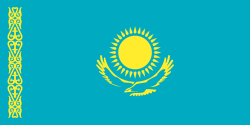



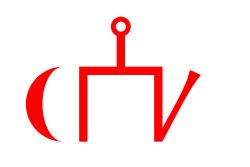
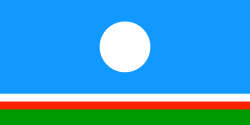

- குன் அனா - சூரியன் (பெரும்பாலான கொடிகளில் இடம்பெற்றுள்ளது)
- உமய் – பெண் கடவுள்
- பய்-உல்கன் – தெங்கிரிக்குப் பிறகு பெரிய கடவுள்
- எர்க்லிக் – விண்வெளியின் கடவுள்
- எர்லிக் – இறப்பின் கடவுள்
- சகா குடியரசின் கொடி
- கசக்கஸ்தான் தேசியக் கொடி
- சுவாஷியா கொடி
- கோக்துர்க் நாணயங்கள்
- வாழ்க்கை மரம்
- ஒக்சோகோ
உசாத்துணை
[தொகு]- ↑ The spelling Tengrism is found in the 1960s, e.g. Bergounioux (ed.), Primitive and prehistoric religions, Volume 140, Hawthorn Books, 1966, p. 80. Tengrianism is a reflection of the Russian term, Тенгрианство. It is reported in 1996 ("so-called Tengrianism") in Shnirelʹman (ed.), Who gets the past?: competition for ancestors among non-Russian intellectuals in Russia, Woodrow Wilson Center Press, 1996, பன்னாட்டுத் தரப்புத்தக எண் 978-0-8018-5221-3, p. 31 in the context of the nationalist rivalry over Bulgar legacy. The spellings Tengriism and Tengrianity are later, reported (deprecatingly, in scare quotes) in 2004 in Central Asiatic journal, vol. 48–49 (2004), p. 238. The Turkish term Tengricilik is also found from the 1990s. Mongolian Тэнгэр шүтлэг is used in a 1999 biography of Genghis Khan (Boldbaatar et. al, Чингис хаан, 1162-1227, Хаадын сан, 1999, p. 18).
- ↑ R. Meserve, Religions in the central Asian environment. In: History of Civilizations of Central Asia, Volume IV, The age of achievement: A.D. 750 to the end of the fifteenth century, Part Two: The achievements, p. 68:
- "[...] The ‘imperial’ religion was more monotheistic, centred around the all-powerful god Tengri, the sky god."
- ↑ Michael Fergus, Janar Jandosova, Kazakhstan: Coming of Age, Stacey International, 2003, p.91:
- "[...] a profound combination of monotheism and polytheism that has come to be known as Tengrism."
- ↑ "There is no doubt that between the 6th and 9th centuries Tengrism was the religion among the nomads of the steppes" Yazar András Róna-Tas, Hungarians and Europe in the early Middle Ages: an introduction to early Hungarian history, Yayıncı Central European University Press, 1999, பன்னாட்டுத் தரப்புத்தக எண் 978-963-9116-48-1, p. 151.
- ↑ 5.0 5.1 Hungarians & Europe in the Early Middle Ages: An Introduction to Early... - András Róna-Tas. பார்க்கப்பட்ட நாள் 2013-02-19.
- ↑ Jean-Paul Roux, Die alttürkische Mythologie, p. 255
- ↑ Saunders, Robert A. and Vlad Strukov (2010). Historical Dictionary of the Russian Federation. Lanham, MD: Scarecrow Press. pp. 412–13. பன்னாட்டுத் தரப்புத்தக எண் 978-0-81085475-8.
- ↑ Mehmet Eröz (2010-03-10). Eski Türk dini (gök tanrı inancı) ve Alevîlik-Bektaşilik. பார்க்கப்பட்ட நாள் 2013-02-19.
- ↑ Fodor István, A magyarok ősi vallásáról (About the old religion of the Hungarians) பரணிடப்பட்டது 2016-05-05 at the வந்தவழி இயந்திரம் Vallástudományi Tanulmányok. 6/2004, Budapest, p. 17–19
- ↑ Tekin, Talat (1993). Irk bitig (the book of omens). Wiesbaden: Otto Harrassowitz. p. 8. பன்னாட்டுத் தரப்புத்தக எண் 978-3-447-03426-5.
- ↑ Balkanlar'dan Uluğ Türkistan'a Türk halk inançları Cilt 1, Yaşar Kalafat, Berikan, 2007
- ↑ McDermott, Roger. "The Jamestown Foundation: High-Ranking Kyrgyz Official Proposes New National Ideology". Jamestown.org. பார்க்கப்பட்ட நாள் 2013-02-19.
Text is available under the CC BY-SA 4.0 license; additional terms may apply.
Images, videos and audio are available under their respective licenses.
